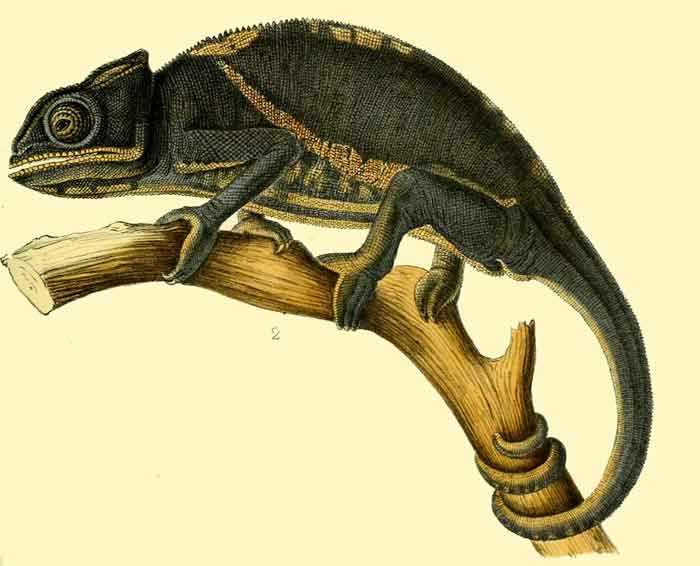
Superregnum: Eukaryota
Cladus: Unikonta
Cladus: Opisthokonta
Cladus: Holozoa
Regnum: Animalia
Subregnum: Eumetazoa
Cladus: Bilateria
Cladus: Nephrozoa
Superphylum: Deuterostomia
Phylum: Chordata
Subphylum: Vertebrata
Infraphylum: Gnathostomata
Megaclassis: Osteichthyes
Cladus: Sarcopterygii
Cladus: Rhipidistia
Cladus: Tetrapodomorpha
Cladus: Eotetrapodiformes
Cladus: Elpistostegalia
Superclassis: Tetrapoda
Cladus: Reptiliomorpha
Cladus: Amniota
Classis: Reptilia
Cladus: Eureptilia
Cladus: Romeriida
Subclassis: Diapsida
Cladus: Sauria
Infraclassis: Lepidosauromorpha
Superordo: Lepidosauria
Ordo: Squamata
Cladus: Unidentata, Episquamata
Cladus: Toxicofera
Subordo: Iguania
Infraordo: Acrodonta
Familia: Chamaeleonidae
Subfamilia: Chamaeleoninae
Genus: Furcifer
Species: Furcifer balteatus
Name
Furcifer balteatus (Duméril & Bibron, 1851)
Type locality: Madagascar.
Holotype: MHNP 6521.
Synonyms
Chamaeleo balteatus Duméril & Bibron in: Duméril & Duméril 1851: 32
Chamaeleo balteus - Angel 1942: 174 (ex errore)
Dicranosaura bifurca var. crassicornis Gray 1865
Chamaeleon balteatus — Gray 1865: 347
Chamaeleon bifidus — Werner 1911: 27 (partim)
References
Duméril, A.M.C. & Duméril, A.H.A. 1851. Catalogue méthodique de la collection des reptiles du Muséum d'Histoire Naturelle de Paris. Gide et Baudry/Roret, Paris, 224 pp.
van Beest, Piet 2004. Herpetologische waarnemingen op Madagascar - deel 1. Lacerta 62(2):48-55.
Nečas, P. 1999. Chameleons – Nature's Hidden Jewels. Edition Chimaira, Frankfurt; 348 pp. ISBN 3-930612-04-6 (Europe). ISBN 1-57524-137-4 (USA, Canada). Reference page.
Furcifer balteatus at the New Reptile Database. Accessed on 17 March 2008.
Vernacular names
English: Rainforest Chameleon
Furcifer balteatus, also known as the two-banded chameleon or the rainforest chameleon, is a species of chameleon that is endemic to Madagascar. It was described by André Marie Constant Duméril and Gabriel Bibron in 1851.
Distribution and habitat
Furcifer balteatus is endemic to southeast Madagascar.[2] It can be found in Ranomafana where the average temperature is between 14 and 20 degrees Celsius (57 and 68 degrees Fahrenheit) and the rainfall is roughly 4,000 millimetres (160 inches) per annum.[3] It has been found over an estimated area of 1,971 square kilometres (761 square miles) but has a "patchy distribution" and is believed by the International Union for Conservation of Nature to be decreasing in population. Most sightings were at a height of 800 to 1,050 metres (2,620 to 3,440 ft) above sea level but some were at lower altitudes. It is a rare species and most of the sightings were of single individuals. Some surveys have failed to locate any individuals and it is ranked as an Endangered species by the IUCN.[1] The major threat to this species is degradation of its forest habitat.[1] It is a CITES-listed species and export from Madagascar has been banned since 1994. Nevertheless, it is believed to be highly desirable to the pet trade and illegal exports are a threat.[1]
Description
Though basically green, Furcifer balteatus is variable in colour and is well camouflaged in its arboreal surroundings. It often has darker green diagonal stripes with paler bands between and usually has a characteristic buff-coloured diagonal streak. The body length can be as much as 24 cm (9 in) and the tail as least as long again. The males have a pair of horny projections 1.5 cm (0.6 in) long on their heads.[3][4] It is commonly known as the two-banded chameleon[5] or the rainforest chameleon.[4]
Taxonomy
The species was initially described in Duméril & Duméril 1851: 32 by Duméril and Bibron. It was described as the Dicranosaura bifurca var. crassicornis by Gray in 1865, and then as Chamaeleon balteatus in 1865: 347 by the same person. It was next described by Angel in 1942 as Chamaeleo balteus. Werner in 1911: 27 later described it under Chamaeleon bifidus, and then it was described as Chamaeleo bifidus fifty-five years later in Mertens 1966.[2] Brygoo and Domergue described it as Chamaeleo balteatus in 1969, and then Brygoo described it under the same name in 1971 and 1978. In 1986, it became known as the Furcifer balteatus. Klaver and Böhme described it as this in 1986, and it was later described under the same name by Glaw and Vences in 1994. Furcifer balteatus was most recently described by Necas in 1999 as Furcifer balteatus.[2]
References
Jenkins, R.K.B.; Andreone, F.; Andriamazava, A.; Anjeriniaina, M.; Brady, L.; Glaw, F.; Griffiths, R.A.; Rabibisoa, N.; Rakotomalala, D.; Randrianantoandro, J.C.; Randrianiriana, J.; Randrianizahana , H.; Ratsoavina, F.; Raxworthy, C.J.; Robsomanitrandrasana, E. (2020). "Furcifer balteatus". IUCN Red List of Threatened Species. 2020: e.T172934A176384350. doi:10.2305/IUCN.UK.2020-3.RLTS.T172934A176384350.en. Retrieved 20 November 2021.
"Furcifer balteatus | The Reptile Database". Reptile-database.reptarium.cz. Retrieved 11 November 2012.
"Furcifer balteatus" (in German). Pantherchameleon.de. Retrieved 11 November 2012.
"Rainforest Chameleon (Furcifer balteatus) [female]". Travel.mongabay.com. Retrieved 11 November 2012.
"Two-banded chameleon videos, photos and facts - Furcifer balteatus". ARKive. Archived from the original on 21 September 2015. Retrieved 11 November 2012.
Retrieved from "http://en.wikipedia.org/"
All text is available under the terms of the GNU Free Documentation License

